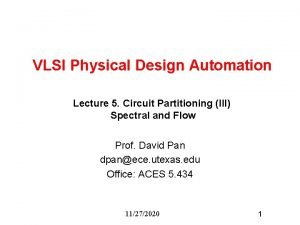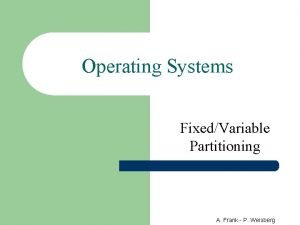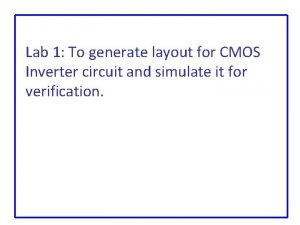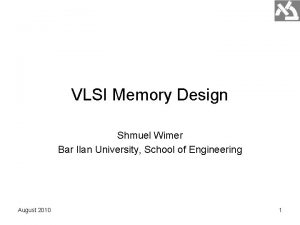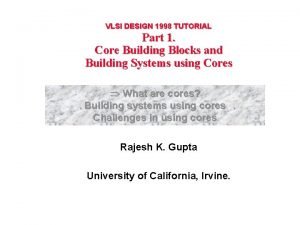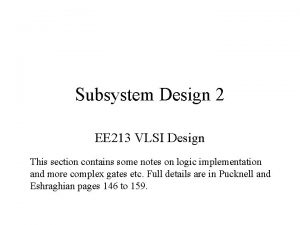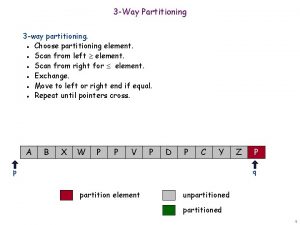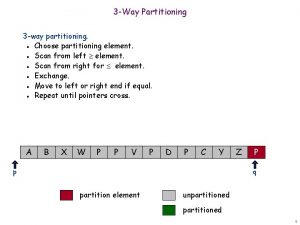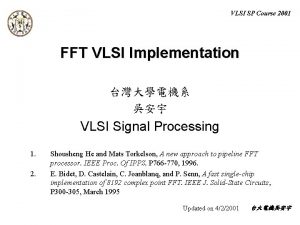VLSI Layout Design Methods Layout Design Steps Partitioning











![Left Edge Algorithm Some Definitions • Interval [xi_min , xi_max] for Net i • Left Edge Algorithm Some Definitions • Interval [xi_min , xi_max] for Net i •](https://slidetodoc.com/presentation_image_h/ed8a465b42ae39621187548cfe89137c/image-12.jpg)



- Slides: 15

VLSI Layout Design Methods

Layout Design Steps • Partitioning – Break up the circuit into smaller functional blocks • Gates, Adders, Multiplexers etc. • Placement – Determine the order in which the blocks are to be arranged on the chip – Semi-custom Design: Standard Cell based (also known as Application Specific Integrated Circuit or ASIC) • Single row • Multiple rows – Full Custom Design • Detailed floorplanning

Layout Design Steps (contd. ) • Routing – Interconnecting functional blocks to complete the Circuit • Global Routing – Assign Wires to different routing channels • Local Routing – Layout design of the individual wires • Placement and Routing are often iterated several times to optimize the design

Partitioning • Circuit expressed as a Graph – Vertex: Each Functional Block – Edge: Wire connecting two blocks B A II Bad Partition I B II Good Partition

Partitioning Kerninghan-Lin Algorithm • Graph G(V, E) Edge-weighted, undirected – |V|=2 n ; Edge (a, b) E Associated weight = ab • Find 2 sets ‘A’ and ‘B’, such that – A B = V ; A B = and |A|=|B|= n – Minimize Cut-cost: ab (a, b) A X B • For some node a in ‘A’ – External Cost: Ea = ay , where a A and y B – Internal Cost: Ia = ax , where a, x A – Define, Da = Ea – Ia

Kerninghan-Lin Algorithm Xm Ym a b Am-1 Bm-1 Ym b Xm a Am • Gain if a and b are interchanged = Da + Db – 2 ab • For chosen sets Xm from Am-1, Ym from Bm-1 – Interchange if is positive – Else, choose new sets • New partition Am and Bm after interchange • Repeat until convergence Bm

Placement A B C D D C B A E F G H Bad Placement Good Placement • Wire length Estimation 1. Euclidean distance: √(x 1 – x 2)2 + (y 1 – y 2)2 2. Manhattan distance: |x 1 – x 2| + |y 1 – y 2|

Simulated Annealing • Physical Process of Annealing: – Heat the material Molecules start moving • Moves to positions to lower Potential Energy – Slowly cool down Freedom of movement arrested • Molecules settles down at Low Potential Energy positions • Simulated Annealing (Statistical Cooling) – Energy correspond to Cost function – Movement Sequence of moves within the set of feasible solutions – Temperature Control parameter determining acceptance probability [exp( – C/T)]

Simulated Annealing (contd. ) 1. Move: f F g N(f); N(f) is neighbourhood of f 2. Compute: (c) = c(g) – c(f); 3. If c 0, then accept = ‘ 1’ else, accept = (exp(– c/T) > random(1) ); [ accept with a probability exp(– c/T)]

Simulated Annealing Algorithm { } struct feasible_solution f, g; -- Outer Loop Changes Temperature float T; f initial_solution( ); do { -- inner loop: configuration randomly perturbed -- and acceptance checked do { g “some element of N(f)” ; if (accept(f, g)) f g while (!thermal_equilibrium()); T new_temperature (T); while (!stop()); “report f ”;

Channel Routing 1 Fixed Terminals 1 4 5 4 1 Floating Fixed 1, 3 3 Terminals 4 Floating Fixed 4, 5 5 Terminals 3 2 5 2 3 Fixed Terminals • Wires run along orthogonal grid lines • Two wiring layers – One layer for horizontal segments only – Other layer for vertical segments only } Reserved Layer Model • Each net realized by a single horizontal segment – Not always possible
![Left Edge Algorithm Some Definitions Interval ximin ximax for Net i Left Edge Algorithm Some Definitions • Interval [xi_min , xi_max] for Net i •](https://slidetodoc.com/presentation_image_h/ed8a465b42ae39621187548cfe89137c/image-12.jpg)
Left Edge Algorithm Some Definitions • Interval [xi_min , xi_max] for Net i • Non-overlapping Horizontal segments – Two nets i and j for which xi_max < xj_min – Can be placed on the same row • No. of intervals at any x position : Local density • Max. local density: Channel’s density (d) – Lower bound on channel width Works on problems with no vertical constraint

• Create i_list { The Algorithm – Arrange nets in increasing order of x O(n. log n) solution while (“i_list not empty”) { f first (i_list); i_list rest (i_list); row ; do { row f ; f “ 1 st element in i_list non-overlapping with f ”; } while (“such an f is there”); solution {row}; } -- O(n) return (solution); -- O(d) }


 çç
çç Fixed partitioning and dynamic partitioning
Fixed partitioning and dynamic partitioning Cmos layout design
Cmos layout design Microwind cmos inverter
Microwind cmos inverter Inverter layout
Inverter layout Wax pattern in fpd
Wax pattern in fpd Memory design in vlsi
Memory design in vlsi Vlsi design flow y chart
Vlsi design flow y chart Biucache
Biucache Subsystem design in vlsi notes
Subsystem design in vlsi notes Mixed signal vlsi design
Mixed signal vlsi design Rom design in vlsi
Rom design in vlsi Vlsi design tutorial
Vlsi design tutorial Y chart vlsi
Y chart vlsi Cpld in vlsi
Cpld in vlsi Ad hoc testable design techniques
Ad hoc testable design techniques
